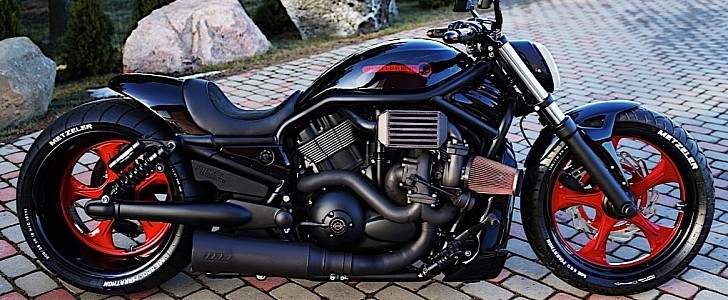In the majority of cases, garages in the business of modifying Harley-Davidsons, old or new, go out of their way to change the appearance of whatever bike, but most of the time limit their intervention on the two-wheeler’s powertrain to slapping in there a beefed-up exhaust system and the occasional air filter. But not Fredy Jaates.
That is the name of an Estonian who has been in the business of really turning Milwaukee-made motorcycles (and, occasionally, cars the likes of the Chevrolet Nova, Lamborghini Murcielago, or Dodge Charger - we'll talk about those at a later date) for a while now.
We’ve featured this guy’s work before, and in the few instances that we did, one thing became perfectly clear: he does not cut any corners, whether we’re speaking about visual enhancements or mechanical upgrades.
As we’ve seen on at least two occasions, Jaates likes to give his motorcycles an extra punch, and he’s fitted Sprintex superchargers on V-Rods to make them a tad more potent. This time, the American muscle bike we have here is the recipient of a Garret turbocharger, a piece of hardware that, even if we’re not told how much more punch it gives this particular bike, is known to significantly increase that in other applications.
The motorcycle started life as a 2002 VRSCA, meaning the first model year of this member of the muscle car family. Aside from the said turbo, and the addition of a Jaates-designed exhaust system, the two-wheeler was also severely beefed from a visual standpoint.
The engine spins new wheels, measuring 19-inch front and 18-inch rear, and wrapped in Metzeler rubber. They’re painted red, just as the lettering on the Rick’s fuel tank, and, together with the chrome fork, they are the only elements that contrast the otherwise perfectly black build.
The fork we mentioned is the beneficiary of a lowering kit and offset at the rear by an Ohlins suspension also modified by Jaates. The rear wheel is a 300 mm conversion, the usual bit chosen by people in the market of giving V-Rods new looks.
A bunch of other big names of the industry are featured on the build. Arlen Ness supplied the brake pedal and shifter pegs, Kellerman the turn signals, and motogadget the instruments.
Boasting a drag-style handlebar and “F1 mirrors,” as the builder calls them, the extreme V-Rod rolled out the garages doors a while ago, but sadly (and as usual when it comes to these Europeans) we are not being told how much it cost to put together. Just to give you a starting point on that, consider a used VRSCA from that year (and mostly in stock form) generally sells on average from just under $10,000.
We’ve featured this guy’s work before, and in the few instances that we did, one thing became perfectly clear: he does not cut any corners, whether we’re speaking about visual enhancements or mechanical upgrades.
As we’ve seen on at least two occasions, Jaates likes to give his motorcycles an extra punch, and he’s fitted Sprintex superchargers on V-Rods to make them a tad more potent. This time, the American muscle bike we have here is the recipient of a Garret turbocharger, a piece of hardware that, even if we’re not told how much more punch it gives this particular bike, is known to significantly increase that in other applications.
The motorcycle started life as a 2002 VRSCA, meaning the first model year of this member of the muscle car family. Aside from the said turbo, and the addition of a Jaates-designed exhaust system, the two-wheeler was also severely beefed from a visual standpoint.
The engine spins new wheels, measuring 19-inch front and 18-inch rear, and wrapped in Metzeler rubber. They’re painted red, just as the lettering on the Rick’s fuel tank, and, together with the chrome fork, they are the only elements that contrast the otherwise perfectly black build.
The fork we mentioned is the beneficiary of a lowering kit and offset at the rear by an Ohlins suspension also modified by Jaates. The rear wheel is a 300 mm conversion, the usual bit chosen by people in the market of giving V-Rods new looks.
A bunch of other big names of the industry are featured on the build. Arlen Ness supplied the brake pedal and shifter pegs, Kellerman the turn signals, and motogadget the instruments.
Boasting a drag-style handlebar and “F1 mirrors,” as the builder calls them, the extreme V-Rod rolled out the garages doors a while ago, but sadly (and as usual when it comes to these Europeans) we are not being told how much it cost to put together. Just to give you a starting point on that, consider a used VRSCA from that year (and mostly in stock form) generally sells on average from just under $10,000.





















